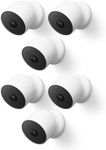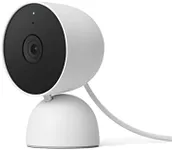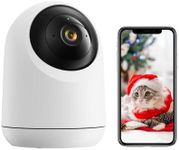Buying Guide for the Best Google Home Cameras
When choosing a Google Home-compatible camera, it's important to consider several key specifications to ensure you get the best fit for your needs. These cameras can enhance your home security and provide peace of mind, but the right choice depends on your specific requirements and preferences. Here are the key specs to consider and how to navigate them.ResolutionResolution refers to the clarity and detail of the video captured by the camera. Higher resolution means clearer and more detailed images. Common resolutions include 720p (HD), 1080p (Full HD), and 4K (Ultra HD). If you need to identify faces or read license plates, a higher resolution like 1080p or 4K is ideal. For general monitoring, 720p may suffice. Consider your need for detail when choosing the resolution.
Field of ViewField of view (FOV) is the extent of the observable area the camera can capture. It is measured in degrees. A wider FOV (e.g., 120-180 degrees) allows the camera to cover more area, which is useful for monitoring large spaces. A narrower FOV (e.g., 90-120 degrees) might be sufficient for smaller areas. Choose a FOV based on the size of the area you want to monitor.
Night VisionNight vision is the camera's ability to capture video in low-light or no-light conditions. This is crucial for 24/7 surveillance. Cameras with infrared LEDs can provide clear images in the dark. The effectiveness of night vision is often measured by the range (e.g., 20-100 feet). If you need to monitor areas at night, ensure the camera has good night vision capabilities.
Two-Way AudioTwo-way audio allows you to listen and speak through the camera using a built-in microphone and speaker. This feature is useful for communicating with visitors or deterring intruders. If you want to interact with people or pets remotely, look for cameras with reliable two-way audio functionality.
Storage OptionsStorage options refer to how the camera saves recorded footage. Common options include cloud storage and local storage (e.g., microSD cards). Cloud storage often requires a subscription but provides access to footage from anywhere. Local storage is a one-time cost but may be limited in capacity. Consider how you want to access and store your footage when choosing a camera.
Smart Home IntegrationSmart home integration refers to the camera's ability to work with other smart devices, such as Google Home. This allows you to control the camera using voice commands and integrate it into your smart home routines. Ensure the camera is compatible with Google Home and other devices you use for a seamless smart home experience.
Motion DetectionMotion detection is the camera's ability to detect movement and trigger alerts or recordings. This feature is important for security purposes, as it helps you monitor activity in real-time. Some cameras offer customizable motion zones and sensitivity settings. If you need to monitor specific areas or reduce false alerts, look for cameras with advanced motion detection features.
Weather ResistanceWeather resistance is crucial for outdoor cameras, as it ensures they can withstand various weather conditions. Look for cameras with an IP rating (e.g., IP65, IP67) that indicates their resistance to dust and water. If you plan to use the camera outdoors, ensure it has a high weather resistance rating to ensure durability and reliable performance.




















